
|
Japanese External Reverse Porro Prism Binoculars. WEBSITE MUSEUM |
|
OTHER BINOCULARS #2 & OPTICAL SIGHTS (MOSTLY MILITARY) |
|
Adding and researching my military and other unusual or interesting non miniature binoculars to create this “other binoculars” section of my website seems to have proven quite popular with viewers, and I am having fun with this section |
|
SARD 7x50 Mark 21 WWII US Navy Military Binoculars |
|
My SARD 7x50 WWII Mark 21 US Navy binoculars were produced by the Kollsman Instrument Co. Inc (which had been purchased in 1940) a division of the New York electric parts company Square D. They were assembled by newly hired workers, to a design licensed from Bausch and Lomb, to fill their June 1942-Feb 1943 contract 88-B-320 from the newly created U.S. Navy purchasing agency BU. Aero/ Bureau of Aeronautics. But of my many military binoculars, these give me an impression of compromised durability and design. For example, despite this example showing absolutely minimal signs of prior use: a screw worked itself loose and is rattling around inside; and the flimsy plastic ocular rings are obviously barely suited for the job; and both filter lenses were fastened so poorly they have just fallen off; and the rattling flimsy rotating eyecup and filter assembly would be clunky even on a kid’s toy. |





|
beh (Leitz) WWII 7X50 German Military Kriegsmarine Navy Binoculars |



|
With rubber ocular armor removed |

|
My WW II beh (wartime German code for E. Leitz Wetzlar) 7x50 binoculars are Kreigsmarine (German Navy) issue, and with their partial rubber armor they were presumably intended as being particularly suitable for smaller boat use (like the fast Schnellboot), where excessive salt water spray was normally expected. While these are often labeled on-line as having been U-boat binoculars to help sell them, I am not sure how many of these were actually intended for that use. The rubber ocular cover ( 1 ) clips to the armor body to hold it out of the way. The cover for the ocular focus adjustment rings ( 2 ) must be removed to focus the binoculars. The binoculars would probably normally be used at infinity, but still focused to each of the users eyes. A Schnellboot (fast boat) WWII German crew member is shown at left with these type binoculars. |


|
blc (Zeiss) WWII 7X50 German Military Kriegsmarine Navy U-Boat Binoculars |



|
My WW II blc (wartime German code for Carl Zeiss Jena) 7x50 binoculars are a Kreigsmarine (German Navy) design specifically for use on U boats, and are the pattern from early 1943 on. Cases of these were captured from storage by the British at the end of WWII, and were sold off as war surplus to companies such as Charles Frank to sell at retail. These are fixed focus, and partially rubber armored. |
|
1 |
|
2 |
|
Of my huge quantity of binoculars, these still never fail to really impress me as having superior optical properties whenever I use them. Because earliest observation and earliest optical detection was critical to U- boat performance and survival, priority was given to excellent optical performance. Mine have desiccant ports, non original paint, original rubber armor, and replacement rubber eye cups. |
|
U-boat crew member with these binoculars |
|
1916 Binocular Prismatic No. 2 Mk II 6x30 British Sherwood & Company Ltd WWI Military Binoculars |





|
My 1916 dated WWI British Military binoculars No 2 MKII are 6x30, and the model was introduced into British military service in 1909. These are marked Sherwood & Co. London 1916 and they were part of a contract of 1,000 No 2 Mk II binoculars placed with Sherwood located at Verulam St., Grays Inn Rd, London EC1 on Feb. 1915, and completed by March 1917. (credit Terence Wayland). The case is marked on the top CASE No2 PRISMATIC BINOCULARS, T. French and Son Ltd, London 1916 , that being Thomas French and Son of Jewin St., London EC1, with their mills in Manchester. For the war they made everything from machine gun belts to webbing equipment, and apparently also binoculars cases . |


|
Facing large broad arrows indicate official UK military property disposal |
|
Broad arrow UK military property mark on binoculars case |
|
Case marked to the officer C.C. SHEARER. |


|
1953 and 1950 A.L. Arm è e du Luxembourg OIP (Optique et Instruments de Precision) 8x38 Military Binoculars |
|
I have two A.L. marked (Arm è e du Luxembourg) 8x38 binoculars, one dated 1950 and the other 1953. These were presumably made in relatively small numbers, as the Luxembourg army was quite small (total strength in 1954 was 7,700 soldiers), and normally only a small percentage of soldiers are issued with binoculars. The 1953 binoculars are hand paint marked with what looks like C/V . and 2/I and the case is hand painted in two places 2/CO. It p robably represents the 2nd Company of the First Infantry Battalion of the Corps de la Garde Grand Ducale. Both my binoculars are marked as having been made by O.I.P Gand , which is Optique et Instruments de Precision: an optical and instrument maker in Ghent Belgium from 1919 to the present day (“Gand” is the French language spelling for Ghent). Both of these binoculars are independent focus, and both have a right ocular horizontal and vertical ranging reticle/ reticule/ graticule. |







|
1944 USN/ US Navy MK 74 Mod.1 Antiaircraft Gun Sight for 3 inch gun mounts Mk20, Mk21, Mk22 |





|
My 1944 dated WWII U.S. Navy Mark 74 Model 1 prismatic 6.11x optical sight is the aiming device for the naval 3 inch anti aircraft artillery guns using the Mk20, Mk21, and Mk22 gun mounts, commonly used on all sorts of vessels including merchant ships in WWII. In common with many other military naval optics, it has a sophisticated rotating polarizing filter wheel to improve visibility in haze and other challenging visibility conditions. And like most mounted naval optics, it is quite heavy at 16 lbs. Made by Honeywell in Minneapolis Minnesota USA. |




|
Mark 74 components |
|
1980’s Leica 8x30 Swiss Army Binoculars |







|
Serial # 03638 |
|
My two pairs of Leica (Kern) 8x30 rubber armored and laser protected Swiss Armed Forces binoculars were built around 1988-1991, after the combined firm of Ernst Leitz and Wild Heerbrugg (merged 1987) had then acquired a majority shareholding of the Swiss optical firm Kern located in Aarau in 1988 (and closed in 1991). As a result both of these binoculars carry the “Leica” brand. (Earlier models were marked “Kern”). One of these binoculars still has it’s military issued Flab monopod, which seems to be quite uncommon, though all of the binoculars have the special stud to mount this design of monopod. One of mine is early, with serial #171, and the other is serial # 3638. |

|
Monopod stud on binoculars |

|
Swiss armored vehicle crew soldier using these type Leica 8x30 binoculars |



|
1950’s Luxembourg soldier using these type binoculars |






|
Contact: miniature.binoculars@gmail.com |
|
Bausch & Lomb 7x50 U.S. Navy Bureau of Aeronautics Mk 28 Military Binoculars Modified to Mk 46 Specification |
|
WWII beh Leitz German 7x50 Kriegsmarine Naval Military binoculars with Interesting Documented U-Boat History and Capture and Ownership History |



|
Doug Williams with unit in Gibraltar in 1946 |

|
Submarine U-485 or U-541 surrendering in 1945 Gibraltar. Courtesy of Imperial War Museum: (photo being used for research & not for profit education ) |
|
©IWMA 29166 |
|
My beh Leitz “ M ” Kriegsmarine marked 7x50 poro II binoculars were obtained in Gibraltar and brought home to the UK by Kenneth Douglas (Doug) Williams, who was in a British military intelligence unit 1945-1946. The Kriegsmarine vessels that surrendered to British forces in Gibraltar and created much excitement were German submarines U-485 and U-541, which surrendered on May 11 & 12 1945. Military intelligence would have had priority access to the subs to examine logs, records, codes, orders, com. gear, and new equipment. Both U-boats would have had some quantity of binoculars like these, and all the binoculars would have been grabbed for reuse or as a high desirability souvenir. As a youngest member of the group, one of the senior officers might well have given binoculars from one of the subs to Doug to bring home. Yes: purely speculative, but is also entirely plausible and logical. Thanks to Les Ong & relatives of Doug Williams for assistance in documentation ! |


|
“ beh ” is Ernst Leitz. “ (T) ” is Transparenzbelag (bloomed), “ KF ” is K ä lte-Fett (cold weather lube) |
|
According to Hans Seeger in “Miliarische Fernglaser und Fernrohre” the large “M” marking is a Kreigmarine property mark, the N might indicate Marinestation Nordsee, and the swastika marking was used 1936-1943. German manufacturer codes were used 1939-1945. So these date to the 1939-1943 period, |

|
These type binoculars pictured in Kriegsmarine use |

|
These type binoculars pictured in Kriegsmarine use |
|
Pre 1904 M. Hensoldt & Sohne Wetzlar Wacht 6x24 Dienstglas F 03 German Army military Binoculars |
|
Dating binoculars can require utilizing all available clues, and documented dates when company nomenclature changed can help. A good example is my German Army Dienstglas “M. Hensolt & Sohne” marked 6 x24 binoculars. According to the Harvard University Collection of Historical Scientific Instruments: “Until 1904 the instruments [binoculars] were signed M. Hensoldt & Sohne Wetzlar“. After that Hensoldt Wetzlar was the standard marking. Therefore my pair of German Army binoculars predate 1904, on binoculars that might otherwise easily incorrectly have been assumed to date to WWI (1914-1918). |








|
The Bu. Aero/ Bureau of Aeronautics was the U.S. Navy’s Naval Aviation materials support organization for design and procurement. (credit Wikipedia). Navy MK 28 binoculars were apparently manufactured 1944-1945. (credit Rohan). The Mk28 binoculars were apparently produced for a 1943 contract to Bausch & Lomb of Rochester NY. |
|
My binoculars are marked as having been modified from a Mk. 28 specification to a MK. 46 specification. I have observed Mk. 28 to Mk. 46, and Mk.46 USMC binoculars dated 1944, so mine and the USMC ones implemented the 1944 contract changes. The pivot marking “DES. PAT. 83,934” refers to design Patent 83,934 issued to Otto Trautman in 1931 and assigned to Bausch & Lomb (credit National Museum of American history). It is my understanding that the “V” prefix in “VY 922” on the pivot indicates 1944 manufacture, with my binoculars probably being serial #922 of M28 binoculars production. |

|
WWII era Navy officer with similar B & L binoculars |

|
1915 WWI Sherwood & Co . 6x Binocular Prismatic No.3 R.I Rifles/ Royal Irish Rifles Military binoculars with British Army broad arrow, marked to soldier J.M. Temple |
|
My 1916 dated WWI British Military binoculars No 3, 6 power British Army binoculars were made by Sherwood & Co. located at Verulam St., Grays Inn Rd, London EC1, and are marked as issued to J.M. Temple, R.I. Rifles/ Royal Irish Rifles. The Royal Irish rifles was established in 1881,served in WWI with huge casualties on the front lines.’, and in 1919 the 2nd battalion went to Iraq, Egypt, Turkey and then India. I have been so far been unable to get documentation on J. M. Temple. |

|
1918 Sherwood & Co Ad |
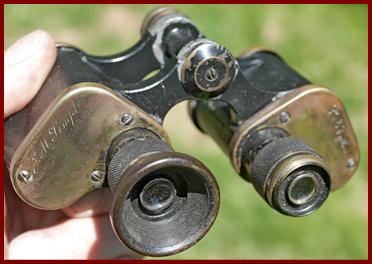

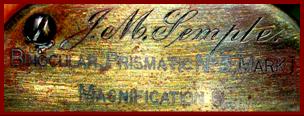



|
NON MINIATURE BINOCULARS & OPTICS: MOSTLY MILITARY |

![Text Box: CLICK ON PAGE LINE. CLIQUEZ SUR LA LIGNE DE PAGE. KLICKEN SIE AUF SEITENZEILE. HAGA CLIC EN LÍNEA DE PÁGINA..[ページ行]をクリックします。НАЖМИТЕ НА СТРОКУ СТРАНИЦЫ. ALSO SEE INDEX.](image851.gif)
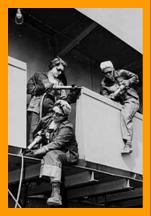


|
WWI Dollond London 8x British Royal Navy broad arrow marked Military Binoculars serial #122129 |

|
My WWI Dollond London 6x Prismatic binoculars are British broad arrow property marked with large yellow body marks I associate with the Royal Navy, then over painted black which I associate with disposal. The original Dolland case is also broad arrow marked and contains spare eye cups. The case and binoculars also contain a painted/ scratched number 1539 that appears to be a property identification, and the binoculars are stamped NP.16. |
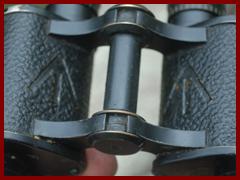
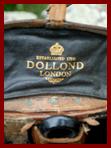

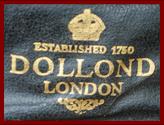



|
OTHER BINOCULARS SECTIONS VIEW COUNT AS OF 11/1/2025: 133,705 VIEW S. |